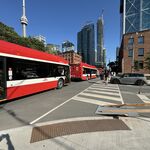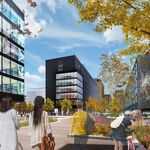Is there an in-between where HFR can be done using the current corridor with just extra tracks? Does anybody know?
There have been so many scenarios. My lowest cost scenario:
- Coproduction on CP from De Beaujeu to Beare
- New heavy duty freight track Coteau to De Beaujeu ( only 6 miles)
- CTC on CP Winchester Sub, not necessarily retaining all double track
- Eight new siding extensions on CP Smiths Falls to Cherrywood, three mile siding length
- Connecting track CN to CP at Beare, and near Belleville
- Complete a third track on Kingston Sub Belleville to Kingston, 40 mph freight speed, not signalled, dedicated to CN roadswitchers, passing track every 20 miles
- Possibly short third track for CN Oshawa to Bowmanville, in Cobourg and Port Hope
VIA takes posession of CN line Liverpool to Coteau. CN retains trackage rights for local shipments only east of Kingston. CN serves Kingston and Bath via local track from Belleville. CN serves customers east of Kingston by roadswitchers based in Brockville, accessed via trackage rights from Smiths Falls
At this point, VIA has eliminated freight interference, which is sufficient to achieve a 4 hour schedule to Montreal and less to Ottawa, on greater frequency, with existing track and signals. From that point, you can incrementally upgrade with gradual growth in ridership.
- ViA slowly upgrades Toronto- Kingston to 120 mph service on the two former CN tracks, which become passenger-only.
- Later, the Gananoque connection is constructed as an incremental project.
- Later, Smiths Falls Sub is double tracked.
- Later, this line is electrified
- Paul




